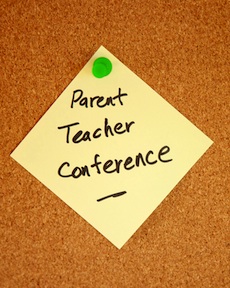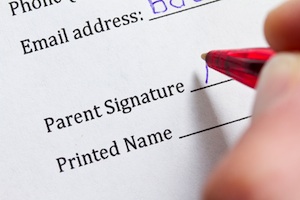Connecting with Parents in Inclusion Classrooms
A MiddleWeb Blog
Connecting with parents in an inclusion classroom begins with developing a positive rapport with students. It includes the two teachers adopting the mindset of “our students.”
In a co-taught classroom, there is no such thing as “my students” or “your students.” Our connection with students and their parents grows out of the decisions, routines, and learning environment that co-teachers create together.
So I’ve been doing a little snooping around. I’ve asked many co-teachers how they introduce themselves to the students on the first day of school. The responses I received varied—yet I found it easy to place all responses into one of three categories:
An Ideal Introduction: The general education teacher and the special education teacher introduce themselves and excitedly express how lucky these students are to have two teachers in the room! (My personal choice)
A Shaky Ground Introduction: The general education teacher introduces herself and mentions that there is another teacher (named Mr. or Ms. So and So). The general ed teacher points to where the special education teacher is standing off to the back or side of the room, and the special education teacher smiles, nods, and waves to the class. (An acknowledgement, but clearly the teachers need to kick it up!).
The Invisible Introduction: The general education teacher mentions there is another teacher who will be in the class—but the special education teacher is not in the room! (There’s just no excuse for this to happen!).
In order for inclusion to be accepted as a natural and meaningful experience, we must think about the way we introduce ourselves to our students (and parents – I’ll get to that soon). We must realize that the messages we send about our own inclusion beliefs weigh heavily on the kind of learning environment we will be creating for the rest of the year.

Admittedly, my findings come from a small random sampling of colleagues I work with and colleagues I have met through social media. But it got me thinking about the kinds of messages that all teachers—everywhere—are sending to their students and parents.
Through our decisions and our actions, we send clear messages about our beliefs. It is easy for observers to see which teachers are comfortable and supportive of inclusion settings. And those who are not on board are equally as transparent. These messages go far beyond our school day. They travel with the students at the end of the day, day after to day, as they return home.
Setting the tone at home
A part of any teachers’ preparation for a new school year must include setting up for ongoing, positive parent communication. All of us organize our parent communication phone/email logs, begin to think about our back to school night presentations, and get ready to send home our beginning course outlines and/or welcome back letters to launch the year with positive connectedness.
In an inclusion class, this first foray into parent communication can get a little sticky sometimes. But if the two teachers in the room are sending positive messages of genuine acceptance for all and for the idea of inclusion, we can pave a smooth pathway for helping those same messages transfer into the home setting.
Two Questions about parents and co-teaching
The topic for this post was inspired by a commenter from my last post and a colleague I just met through collaborating on Twitter. They asked me two questions that deserve some deep thinking and ready action on the part of all co-teachers. I will get us started, and I hope you will jump in and share your voice on this important topic….

The link to effective parent communication must begin with a solid foundation of understanding and acceptance that is set within the classroom environment by co-teachers. Additionally, there must be a culture of support within the building and district, so that the teachers have the professional development they need as well as the time to establish a working co-teaching partnership.
When the foundation is there, and students feel that sense of belonging in classrooms, teachers are more successful in creating a positive network of communication with parents. Here are a few observations from my own experience:
• Co-teachers must discuss their parent contact/communication philosophy with each other at the beginning of the year. Teachers should collaborate on an ongoing basis to make sure that all parents feel the perks that inclusive education has to offer. I think it is important for both teachers to take responsibility for communicating with all parents.
• Once co-teachers have a sense of community in their classroom, and they are comfortable with the flexibility and identification of their individual and combined roles, they can begin to explain to parents that inclusion is a learning environment like any other. It has increased supports to really power up the process of learning to guide students to personally connect and achieve.
• Both teachers should introduce themselves at Back to School Night. Parents should have the sense that an inclusion classroom holds all students to the same high standards, and the process of learning with two teachers challenges and allows for each student to achieve at his or her personal best.
• When student and/or parent concerns and celebrations arise—both teachers should share the responsibility of connecting with parents.
• Parents should be included when creating a sense of belonging in the learning environment.
• Open communication should be ongoing, so parents are connected with what is happening in the class. In this proactive manner the teachers can address parent concerns effectively.
2. What do we say to the parents of high performing and gifted students who will be enrolled in an inclusion class alongside students with special needs?
In addition to the above tips….

• Teachers should share examples of learning options, so parents are aware. For example, teachers can incorporate problem-based learning and independent research activities to encourage students to take charge of their learning.
Let’s make this a conversation. In the Comments, tell us . . .
How are you creating inclusion connections with all parents? What do you share with parents of high performers?
And please join us for our next co-teaching chat on Twitter: Tuesday, 9/10 from 8:00-8:45 EDT—Topic: Creating Effective parent communication. Use the hashtag #coteachat to join the discussion.
See you there! We have so much to discuss, share, and learn from one another!



































Elizabeth,
Thanks for sharing so many great strategies for parent communication. I agree that it is important for BOTH teachers to communicate both celebrations and concerns with all parents in the classroom. We make it a point to encourage teachers to have both teachers’ names on the syllabus and on any communication that goes home (blog, newsletter, etc), have both teachers’ names on the door, and, at the secondary level, we try to have both teachers listed as “teachers of record” within out electronic grade reporting system. Each of these items communicates to parents that both teachers have equal, shared responsibility for the class. If you leave either of the teachers off, it communicates to parents that one is “less important” or “less involved.”
Thanks for more great food for thought!
Hi, Christie,
Thank you for your thoughtful and informative comments! You share the value of parity as well as provide some easy to do steps teachers and administrators can take to make sure that positive messages are created and nurtured–it can go a long way!
Best,
Elizabeth
Dear Elizabeth and Christie,
In what states do you teach? My son, who is disabled, goes to a school in California, where per student funding of schools is about 49th in the nation. He is in a regular classroom with an aide (who is un-credentialed, appears to be very lightly educated) and he also has a special ed teacher (who refers to herself as a “caseworker”). She occasionally “pushes in” but she has a huge caseload, so limited time for any given student. I’ve never heard of classrooms with two fulltime (i.e. GE and SE) teachers. Is that the norm in other states?
Ben
Ben, thanks for sharing your thoughts here. I teach in New York. It is typical for a special ed teacher at the elementary level to be in the classroom for 3 hours and a special education aide to be in the room the other 3 hours. The special ed. teacher should collaborate with the aide (and the gen. ed. teacher) to ensure that the services provided are effective in meeting the needs of the students. At the secondary level, the special education teacher co-teaches for full period classes–following the all too familiar bell system. Therefore, at the secondary level, there is that full-time GE and SE feel.
Here’s a link that could provide you with some more information on a variety of related topics:
http://www.air.org/focus-area/education/
Thanks for adding your voice here–and all the best to you and your family!